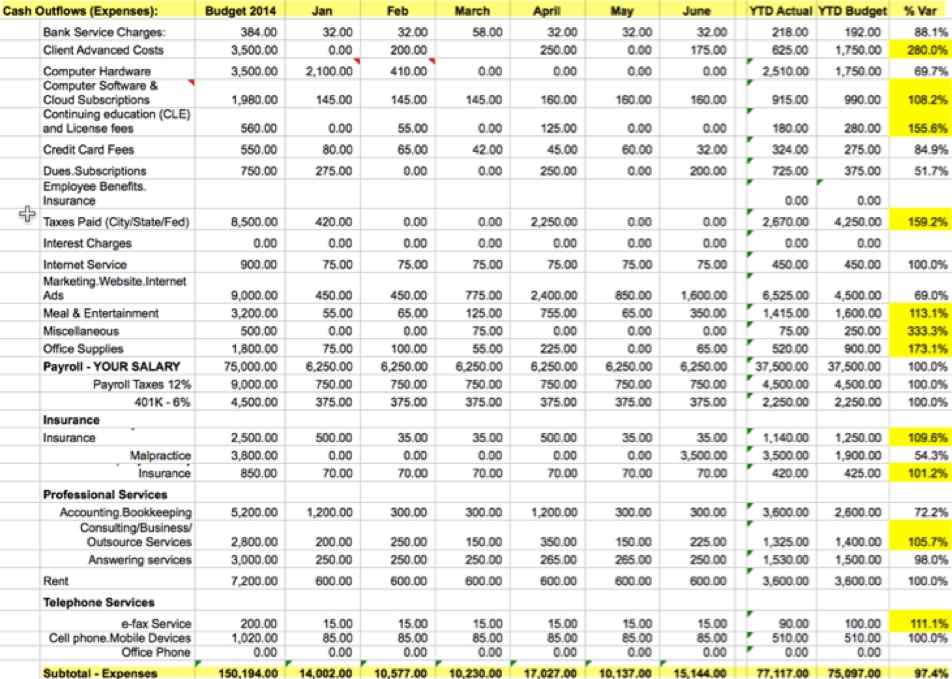This article was originally written for Attorney at Work in 2014. It has been re-written and updated for this blog post.
So it’s July and you will be sitting down to reconcile your bank accounts for June’s activity. This is an exercise you do (should be doing) every month. As long as there’s money in the checking account, life must be good – right? Maybe, but it begs the question – How profitable is your law firm and can it be doing better?
Six months are in the books and now is a good time to evaluate a few of your firm’s financial metrics and law firm profitability before you plow through the next 6 months of the year. Step back and review where you are in relation to your 2016 budget you created in January. Are you profitable and making money yet? If you never created that budget, no worries, this article will help you plan for the next six months with a budget and a system in place. I have included a sample budget tracker spreadsheet for you to start with now.
While looking at the financial data and key metrics you should be tracking and measuring, let’s ask a few questions to get you in the mindset of looking at your firm as a business and preparing for a more successful next six months.
1. Are you paying yourself a monthly salary and is it enough to cover your personal expenses? Or are you randomly taking money out of the business when the bank account looks healthy enough to do so?
Goal: Build you salary into your budget along with payroll taxes. It is tempting to just randomly take out money but the tax implications for this habit will catch up with you the next year. This task also requires you to create a personal budget so you know how much salary you and your family need in order to pay the monthly bills and save for your kids college!
2. Do you know what you have to bill and collect every month to cover your firm’s monthly expenses, which includes your salary? This is your monthly “nut” – the money you will need very month to pay fixed expenses. Know your “nut” assumes you know your monthly fixed expense.
Goal: Calculate your “monthly nut.” Put this number in a very visible place so you look at it every month as a reminder that once you hit this number, you are making profit for your family and your future retirement.
3. Does your budgeted income number reflect your collection realization rate?
If you budget to bill 1500 hours/year at $200/hour, your budgeted revenue is $300,000. But it’s not a perfect world and this is not what will be collected. Knowing your collection realization rates will help you set a realistic revenue number to drive your budget.
Goal: Calculate your YTD 2016 collection realization rate. Shocked at how low it might be? A collection realization rate of 90% should be an attainable goal for you. If it seems daunting based on how low your current collection rate is, don’t worry. This is one area of your financial dashboard that you can improve upon by changing billing habits and tracking accounts receivable.
4. Do you know your year-to-date profit or lose? How are your actual numbers compared to what you budgeted for? A profit and lose statement is sometimes referred to as an income statement. It is simply an accounting report comparing revenue/income to expenses, usually shown monthly compared to last month for the same time period.
Income is based on a few things discussed above: billing and collections. Expenses are something that can surprise you if you are not tracking them monthly. Having the prepared budget you review each month is invaluable for tracking expenses. You may not think you are spending a lot of money until you see it in writing.
Goal: Make sure your accounting system is setup with a chart of accounts that segregates expenses by categories that you wish to track. Then every month enter the actual amounts spent and watch for any unusual trends. If one month was higher than usual, adjust for the remaining months so you don’t overspend.
5. Do you have a cash flow report that you can look at every month?
A cash flow report is simply a way for you to keep an eye on your actual checking account balance. If you are reconciling every month and updating your budget/financial tracker spreadsheet, then you will know how much you are starting with every month – with enough money in the checking account or not enough. Once again, it gives you data to make decisions about your business so you can be proactive and not reactive.
In the sample budget tracker/financial spreadsheet, the beginning cash balance for the next month is calculated this way:
Goal: Commit to reconciling your bank accounts within the first few days of each month and updating your budget/financial tracker spreadsheet with the reconciled amount. Having correct and current data is essential for making good business decisions.
6. How many hours and dollars are you billing each month and what is your average hourly rate?
You can’t get paid unless you are billing every month. Knowing how much you are billing every month and what the trends are will help you see your financial future, not through rosy glasses but actual numbers.
Goal: Track your billable hours and bill promptly and regularly. Train your clients to expect to pay monthly for their legal services.
7. How many new matters are you setting up each month and what has been the trend? Is the pipeline full for continued cash flow? Do you have an even balance of hourly vs. flat fee vs. contingent?
Goal: Track the number of new matters per month and visualize the growth. A month with a low number of new matters can signal less income in the coming months. Especially combined with a low beginning check register balance. Knowing this ahead of time can help you prepare. Maybe look at expenses closely over these upcoming months and defer expenses if possible.
8. What is your six-month collection realization rate? Is this a weak spot and a reason for low revenue numbers? Your collection realization rate is the percentage of your billed fees that is actually collected. Pretty simple stuff. Collection realization rates are often overstated because lawyers tend to leave uncollectible receivables in the system for an unrealistic time period, rather than admit the money will never be collected.
Goal: Commit to calculating your six-month collection realization rate and for the remainder of the year, set a goal to increase this by 2%. An increase of 2% can yield additional money without doing more work.
9. What are your outstanding accounts receivable 30, 60, 90 and over 90 days? This is an area that can yield additional profit for your firm, without putting in longer hours, by simply tighten up or putting in place good receivable management practices. You are not in the business to extend credit and make loans. Set expectations with your clients’ early on regarding payment of invoices. You are a small business owner and cash flow is important. They should understand and respect your business needs. If they don’t, fire them.
Goal: Implement monthly billing procedures and collect all payments before they hit 90 days past due. Create a procedure to send letters requesting payments once account hits 60 days past due and then follow-up regularly. Analysis past due accounts in excess of 1 year. They have little chance of being collected. So don’t count on this money coming in. Write if off and move on.
10. Don’t have a budget or method to track your firm’s financial data? Use the summer month of July to build yourself a nice spreadsheet so you are ready for the next six months in 2016. This is an invaluable exercise and once done, it easily converts to an annual worksheet.
Improved understanding of these financial metrics will assist you greatly with strategic business development initiatives–all of which are critical to remaining competitive and profitable as a solo and small firm attorney.
Written by Peggy Gruenke with CPN-Legal, a company whose mission is to help solo and small-firm lawyers build better businesses. She is active in the ABA GPSolo Division and a frequent speaker at bar associations and ABA TechShow.












